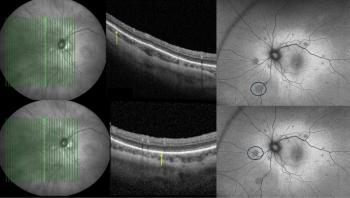
A review of the DAVIO 2 phase 2 trial results
A hope for reducing treatment burden for wet age-related macular degeneration with a sustained-release vorolanib intravitreal insert
Katherine Talcott, MD, of Cleveland Clinic in Cleveland, Ohio, presented results of the phase 2 DAVIO 2 trial (NCT05381948) of EYP-1901 (vorolanib intravitreal insert; a/k/a DURAVYU) for
Wet AMD has a high treatment burden, typically requiring frequent anti-VEGF injections for optimal outcomes. However, real-world clinical studies show that most patients are not receiving injections at a rate that maintains vision over time, and a significant proportion of patients discontinue treatment altogether.2,3 Recently-approved therapies aim to reduce treatment burden in wet AMD; however, the sustained-delivery device Susvimo (port delivery system with ranibizumab; Genentech, Inc) requires surgery for implantation, 4 and other recently-approved products (Vabysmo, Genentech, Inc; Eylea-HD®, Regeneron Pharmaceuticals) have achieved incremental improvements. 5-7
Talcott’s presentation focused on phase 2 clinical trial results of a therapeutic in development: EYP-1901, which aims to reduce treatment burden for wet AMD. This candidate is a bioerodible, sustained-release intravitreal insert delivering the potent and selective tyrosine kinase inhibitor (TKI) vorolanib over at least 6 months. TKIs, including vorolanib, inhibit the VEGF receptor intracellularly, thereby inhibiting angiogenesis and exudation. 8
This insert uses Durasert-E drug delivery technology, a next-generation, bioerodible version of the Durasert intravitreal insert used in 4 FDA-approved intraocular indications to date.9-12 The insert, composed of 94% vorolanib/6% matrix, is designed to deliver a consistent daily dose of vorolanib for at least 6 months starting from the day of administration, with all drug released before matrix bioerosion to ensure no uncontrolled drug release. It does not require cold storage.
DAVIO 2, the only phase 2 and largest completed clinical trial of an intravitreal TKI to date, assessed efficacy and safety of a single injection of EYP-1901 compared with on-label aflibercept 2.0 mg every 8 weeks (q8W) in patients with previously treated wet AMD.
In total, DAVIO 2 enrolled 161 patients who received 3 monthly loading doses of aflibercept 2.0 mg, followed by either sham and aflibercept 2.0 mg Q8W thereafter; a single injection of EYP-1901 2 mg; or a single injection of EYP-1901 3 mg. Starting at week 12, all patients were assessed every 4 weeks for supplemental aflibercept 2.0 mg injections using prespecified best-corrected visual acuity (BCVA) and anatomic criteria; supplementation per investigator discretion was permitted. The primary end point was BCVA change from day 1 to week 28/32, averaged.
Patients in DAVIO 2 had significant treatment experience prior to the trial, averaging approximately 2 years since wet AMD diagnosis with an annualized mean of 10 anti-VEGF injections in the year before enrollment. On average, patients began DAVIO 2 with baseline vision ~73–75 ETDRS letter score (~20/32 Snellen equivalent) and CST ~263–266 μm.
DAVIO 2 met its primary end point, with both EYP-1901 2 mg and EYP-1901 3 mg providing similar vision outcomes as aflibercept Q8W at months 7/8 (averaged), as well as stable CST. These vision and CST outcomes were maintained throughout the 1-year trial in all arms.
Notably, patients in the EYP-1901 arms experienced substantial reductions in treatment burden, with 63% of patients receiving no supplemental aflibercept injections up to month 8, the expected minimum duration of EYP-1901. The median time to first supplemental aflibercept injection was 37/41 weeks (~9-10 months) after EYP-1901 2 mg/3 mg administration, with EYP-1901-treated eyes receiving a median of 1.1 supplemental injections through the end of the 56-week trial. These results reflect a treatment burden reduction of ≥80% compared with the patients’ own pretrial treatment frequency and ≈70% vs aflibercept Q8W-treated eyes through 1 year.
EYP-1901 had a favorable safety profile in DAVIO 2, with no EYP-1901-related ocular or systemic serious adverse events, no insert migration into the anterior chamber, no cases of retinal occlusive vasculitis, and no discontinuations related to this treatment.
Overall, EYP-1901 demonstrated noninferiority to aflibercept with stable BCVA, a favorable safety profile, and substantially reduced treatment burden in DAVIO 2.
Following the positive results from DAVIO 2, pivotal phase 3 clinical trials LUGANO (NCT06668064) and LUCIA (NCT06683742) began in late 2024 and are currently enrolling. As presented in a separate poster by Nimesh Patel, MD, of Massachusetts Eye and Ear and Harvard Medical School in Boston, MA, LUGANO and LUCIA aim to demonstrate that EYP-1901, when administered every 6 months, achieves similar visual outcomes to on-label aflibercept while reducing treatment burden in patients with wet AMD. 13
These pivotal, parallel, global trials each aim to enroll ~400 patients with active AMD, including patients with treatment-naive or previously-treated wet AMD. Building upon the findings of DAVIO 2, all patients will receive active treatment; following 3 monthly aflibercept 2.0 mg injections, patients are randomly assigned to receive either EYP-1901 2.7 mg with redosing every 6 months or on-label aflibercept 2.0 mg. Patients will be assessed for supplemental aflibercept injections per prespecified criteria at each visit. The primary end point of these noninferiority trials is BCVA change from baseline at weeks 52/56 blended. Secondary end points include safety, anatomic stability, reduction in treatment burden, and proportion of eyes supplement-free.
Conclusion
EYP-1901 (DURAVYU) is designed to continuously provide VEGF receptor inhibition via the TKI vorolanib from the day of administration through at least 6 months. The phase 2 DAVIO 2 trial demonstrated the potential to substantially reduce treatment burden in wet AMD while maintaining vision. Ongoing phase 3 LUGANO and LUCIA trials, designed based on learnings from DAVIO 2, will further assess the potential of EYP-1901 as a novel therapeutic for wet AMD.
DURAVYU has been conditionally accepted by the FDA as the proprietary name for EYP-1901. DURAVYU is an investigational product; it has not been approved by the FDA. FDA approval and the timeline for potential approval are uncertain.
Disclosure: Talcott is a consultant for EyePoint Pharmaceuticals, Inc.
References
1. Talcott K, Ribeiro R. Assessment of treatment burden in wet age-related macular degeneration treated with EYP-1901 (vorolanib intravitreal insert) versus aflibercept: DAVIO 2 trial results. Presented at: Association of Research in Vision and Ophthalmology (ARVO) annual meeting; 2025; Salt Lake City, UT.
2. Ciulla TA, Hussain RM, Taraborelli D, Pollack JS, Williams DF. Longer-term anti-VEGF therapy outcomes in neovascular age-related macular degeneration, diabetic macular edema, and vein occlusion-related macular edema: Clinical outcomes in 130 247 eyes. Ophthalmol Retina. Sep 2022;6(9):796-806.
3. Wykoff CC, Garmo V, Tabano D, et al. Impact of anti-VEGF treatment and patient characteristics on vision outcomes in neovascular age-related macular degeneration: Up to 6-year analysis of the AAO IRIS® registry. Ophthalmol Sci. Mar-Apr 2024;4(2):100421.
4. SUSVIMO® (ranibizumab injection) for intravitreal use via SUSVIMO ocular implant: Prescribing information. Last updated 2/2025. Genentech Inc., South San Francisco, CA.
5. Khanani AM, Kotecha A, Chang A, et al. TENAYA and LUCERNE: Two-year results from the phase 3 neovascular age-related macular degeneration trials of faricimab with treat-and-extend dosing in year 2. Ophthalmology. Aug 2024;131(8):914-926.
6. Lanzetta P, Korobelnik JF, Heier JS, et al. Intravitreal aflibercept 8 mg in neovascular age-related macular degeneration (PULSAR): 48-week results from a randomised, double-masked, non-inferiority, phase 3 trial. Lancet. Mar 23 2024;403(10432):1141-1152.
7. Varma D, Talks J, de Salvo G, et al. Real-world treatment patterns and outcomes in the first 6 and 12 months of faricimab use among eyes with neovascular age-related macular degeneration (nAMD) in the UK: FARWIDE-nAMD. Invest Ophthalmol Vis Sci. 2024;65(7):4905-4905.
8. Bakri SJ, Lynch J, Howard-Sparks M, Saint-Juste S, Saim S. Vorolanib, sunitinib, and axitinib: A comparative study of vascular endothelial growth factor receptor inhibitors and their anti-angiogenic effects. PLoS One. 2024;19(6):e0304782.
9. ILUVIEN® (fluocinolone acetonide intravitreal implant) 0.19 mg for intravitreal injection: Prescribing information. Last updated 11/2016. Alimera Sciences, Inc., Alpharetta, GA.
10. YUTIQ® (fluocinolone acetonide intravitreal implant) 0.18 mg: Prescribing information. Last updated 6/2023. Alimera Sciences, Inc., Alpharetta, GA.
11. RETISERT (fluocinolone acetonide intravitreal implant): Prescribing information. Last updated 4/2025. Bausch & Lomb Inc.Bridgewater, NJ.
12. Wykoff CC, Kuppermann BD, Regillo CD, et al. Extended intraocular drug-delivery platforms for the treatment of retinal and choroidal diseases. J Vitreoretin Dis. Sep-Oct 2024;8(5):577-586.
13. Patel N, Ribeiro R. LUGANO and LUCIA trial design: Pivotal phase 3 studies of EYP-1901 vs aflibercept in wet age-related macular degeneration. Presented at: Association of Research in Vision and Ophthalmology (ARVO) annual meeting; 2025; Salt Lake City, UT.
Newsletter
Keep your retina practice on the forefront—subscribe for expert analysis and emerging trends in retinal disease management.













































